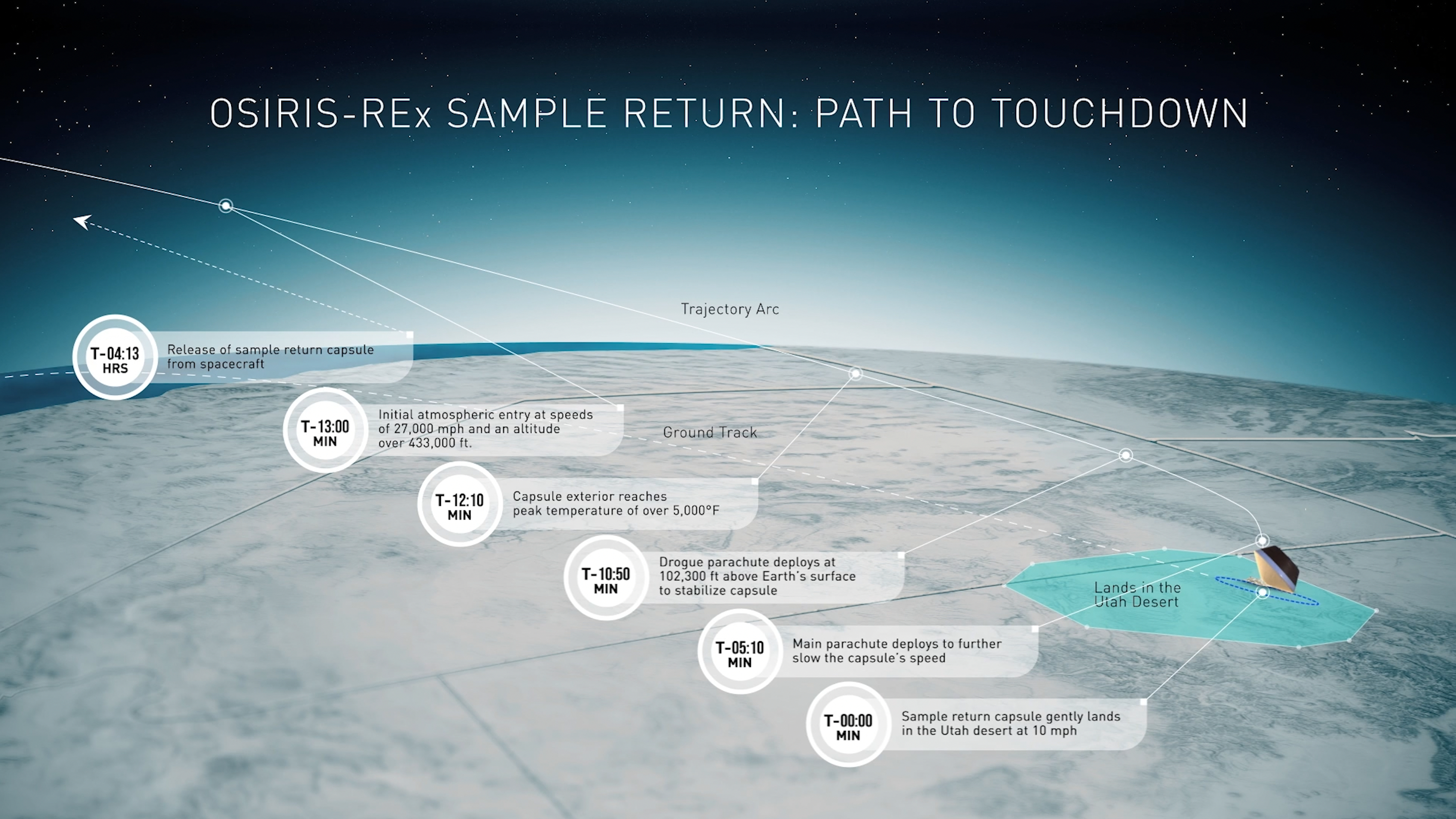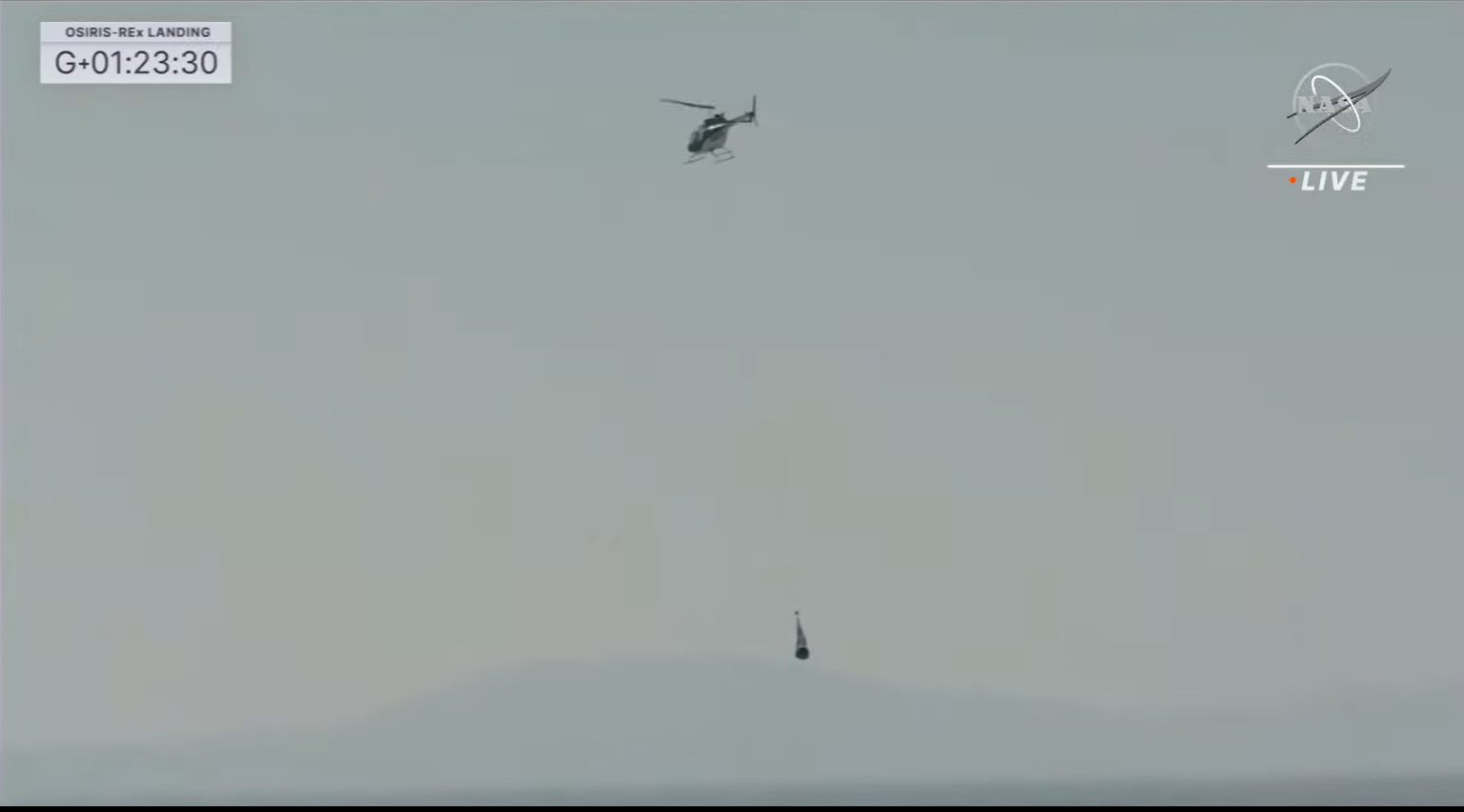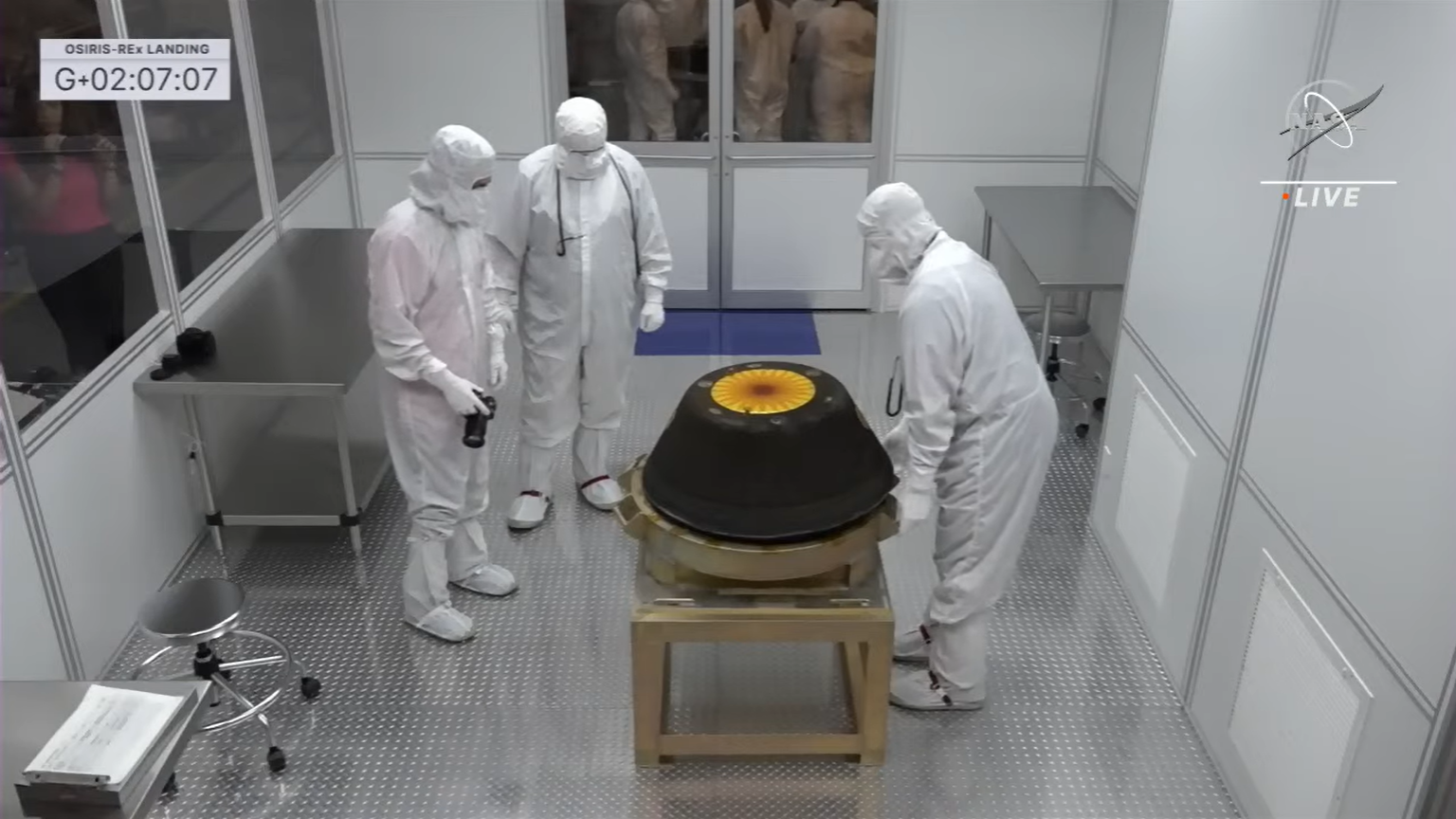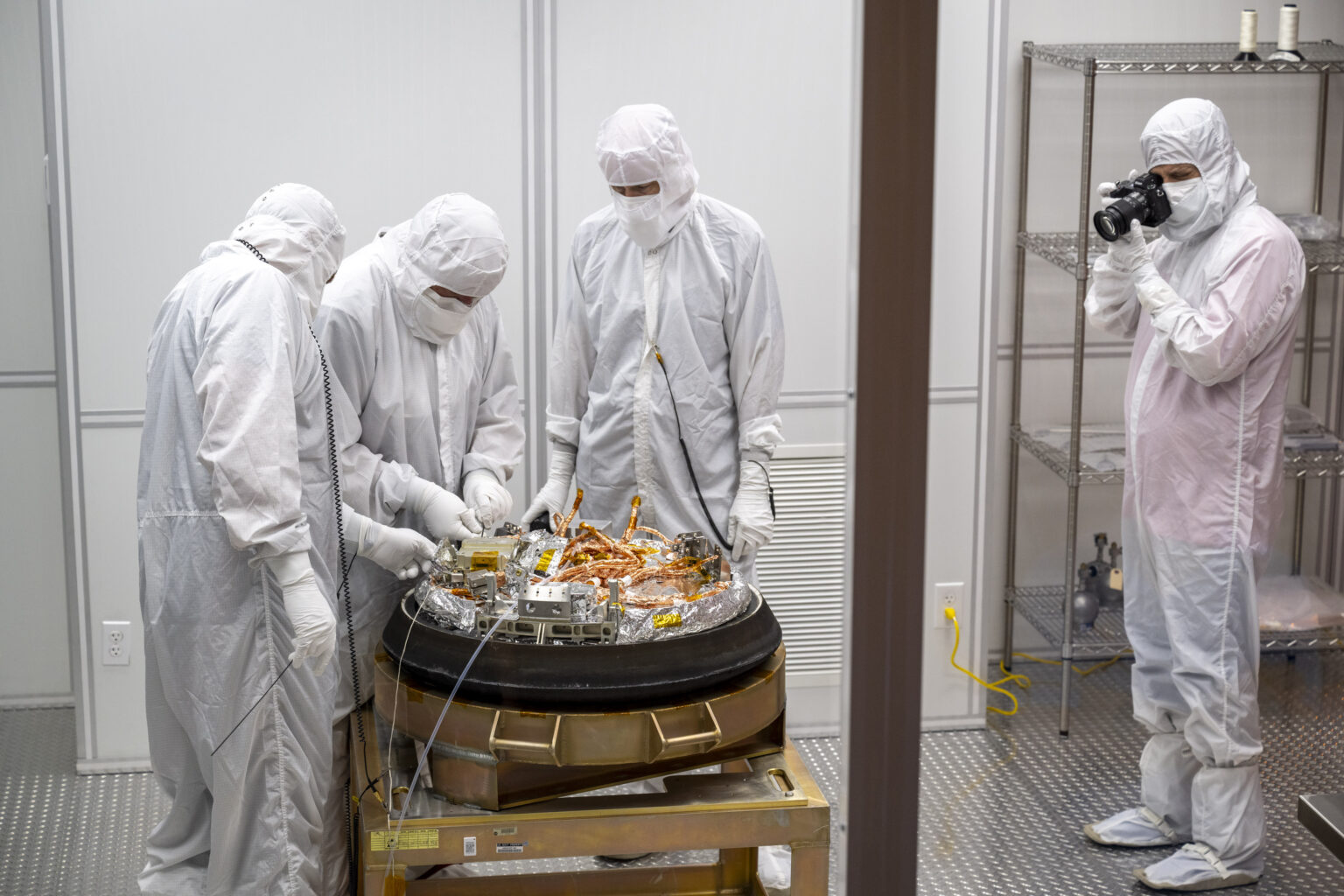NASA's OSIRIS-REx asteroid sample return to Earth: Live updates
OSIRIS-REx's asteroid-sample return capsule will land in Utah on Sept. 24 at around 10 a.m. EDT (1400 GMT). Here's the latest.
On Sept. 24, 2023, NASA's OSIRIS-REx mission made U.S. history by returning samples of the asteroid Bennu to Earth after seven years in deep space.
Launched in 2016, the OSIRIS-REx spacecraft reached asteroid Bennu in October 2020 and collected samples from the near-Earth asteroid's surface. On Sept. 24, it returned those samples in a special capsule and parachute, with a landing at Department of Defense's Utah Test and Training Range near Dugway, Utah. See the latest on the asteroid sample-return's approach, landing and sample processing here.
The landing in 5 steps | OSIRIS-REx mission | Asteroid Bennu
OSIRIS-REx 1 week from asteroid sample return
NASA is just one week away from the epic landing of its OSIRIS-REx asteroid sample-return capsule, which is packed with pieces of the asteroid Bennu. The landing, which is on track for Sept. 24, 2023, will mark the end of OSIRIS-REx's primary 7-year mission that began with a launch in 2016 and sample-collection at Bennu in October 2020.
Scientists are excited, but also on tenterhooks, as they prepare for OSIRIS-REx's return to Earth. The spacecraft will slam into Earth's atmosphere, protected by a heat shield, and reach speeds of up to 27,000 mph before deploying drogue and main parachutes to slow itself to a more manageable 10 mph.
As NASA prepares for the OSIRIS-REx landing, check out our latest coverage below and stay tuned for daily updates leading up to the landing itself!
OSIRIS-REx asteroid probe heads toward Earth for Sept. 24 sample delivery
NASA's OSIRIS-REx probe put itself on course toward Earth with a thruster firing on Sept. 10, two weeks before its highly anticipated asteroid-sample delivery.
NASA's OSIRIS-REx mission almost bit the dust — then Queen guitarist Brian May stepped in
That the mission ultimately succeeded is in part due to Queen guitarist Brian May, who meticulously created 3D images of the rubble pile to help the mission leaders identify safe landing spots.
NASA conducts crucial drop test ahead of Sept. 24 arrival of OSIRIS-REx asteroid sample
The OSIRIS-REx team performed a crucial drop test on Wednesday (Aug. 30), practicing what they'll do when the mission's real asteroid sample comes home on Sept. 24.
OSIRIS-REx science chief reveals NASA's 1st asteroid sampling mission nearly didn't make it (exclusive interview)
Dante Lauretta, the chief scientist of NASA's OSIRIS-REx mission, talks about the unexpected challenges of NASA's first asteroid sampling attempt in an exclusive interview.
Here's how asteroid Bennu caught NASA's OSIRIS-REx by surprise
When NASA's OSIRIS-REx probe arrived at asteroid Bennu in 2018, it didn't look like mission planners had envisioned.
"I really thought we might be in trouble there," the mission's chief scientist Dante Lauretta told Space.com. Because the asteroid's surface looked so different from how the OSIRIS-REx team thought it would, the spacecraft had to be reprogrammed in order to land on Bennu's loose, gravely surface.
But Bennu still had some more surprises in store for the spacecraft as it touched down to collect a sample. Read about how asteroid Bennu caught NASA's OSIRIS-REx spacecraft by surprise and nearly killed it along the way in our feature here as we countdown to the OSIRIS-REx spacecraft dropping off this cargo at Earth on Sunday, Sept. 24.
How much asteroid stuff is in OSIRIS-REx?
OSIRIS-REx's descent capsule should descend on Earth on Sunday (Sept. 24), under parachutes in the Utah desert.
Inside is a precious sample indeed: the spacecraft picked up material from a 1,650-foot-wide (500 meters) near-Earth asteroid named Bennu in October 2020 that likely contains information about the solar system's history. But how much material is in there?
Read more: How much asteroid material is NASA's OSIRIS-REx probe delivering to Earth this weekend?
OSIRIS-REx makes final maneuver before Sept. 24 sample delivery
NASA's OSIRIS-REx probe is on track for its historic delivery.
The spacecraft performed one last trajectory-correcting maneuver on Sunday (Sept. 17) to prepare for its Sept. 24 return of its asteroid sample here on Earth. The probe is currently about 1.8 million miles (2.8 million km) away, speeding toward Earth at roughly 14,000 mph (23,000 kph).
When it reaches about 63,000 miles (102,000 km) above Earth on Sunday (Sept. 24), it will send a capsule containing samples of asteroid Bennu down inside of a 36-mile by 8.5-mile target area in the Utah desert, where teams of NASA and U.S. military personnel will be standing by to recover it.
Related: OSIRIS-REx asteroid probe makes final maneuver before Sept. 24 sample delivery
OSIRIS-REx changed how we think about asteroids
When astronomers studied OSIRIS-REx's target asteroid Bennu through telescopes, they thought that the rock would be a solid mass. They were in for a surprise.
OSIRIS-REx hasn't yet returned its samples of asteroid Bennu, but the mission has already shown that asteroids are much more than just rocks floating through space. In fact, their geology appears surprisingly complex.
As it turns out, Bennu is a "hellscape" of loose gravel and porous, low-density boulders, according to Kevin Walsh, lead scientist of the Regolith Development Working Group of the OSIRIS-REx mission.
The samples of asteroid Bennu taken by NASA's OSIRIS-REx spacecraft are scheduled to return to Earth on Sunday (Sept. 24).
Related: NASA's OSIRIS-REx spacecraft changed how we think about asteroids. Here's how.
How NASA's OSIRIS-REx will bring asteroid samples to Earth
Curious about how NASA plans to return its first asteroid samples to Earth?
The samples of asteroid Bennu currently stored inside a capsule onboard NASA's OSIRIS-REx spacecraft are about to face the bumpiest part of their 1.2 billion-mile (1.9 billion-kilometer) journey to our planet.
There are several key steps in the capsule's landing and recovery in the Utah desert currently scheduled for 10:55 a.m. EDT (1455 GMT) on Sunday (Sept. 24). Read all about how NASA's OSIRIS-REx will bring asteroid samples to Earth in 5 not-so-easy steps.
And while you're at it, submit your favorite rock-related tracks for Third Rock Radio's "Return of the Rock" OSIRIS-REx playlist. Your picks could be chosen and highlighted by NASA's social media channels to celebrate the asteroid sample return!
Read more: How NASA's OSIRIS-REx will bring asteroid samples to Earth in 5 not-so-easy steps
OSIRIS-REx probe spotted in deep space returning asteroid sample to Earth
We just got a look at NASA's OSIRIS-REx probe in deep space as it carries its asteroid sample toward Earth.
The European Space Agency's (ESA) Optical Ground Station telescope in the Canary Islands captured an image of the OSIRIS-REx spacecraft on Sept. 16 as it speeds towards our planet where it will release its sample capsule to land in the Utah desert on Sunday (Sept. 24).
When the image was taken, OSIRIS-REx was 2.9 million miles (4.66 million kilometers) away from Earth, having already journeyed nearly 1 billion miles (1.9 billion kilometers) since leaving asteroid Bennu.
Read more: OSIRIS-REx probe spotted returning asteroid sample to Earth (photo)
OSIRIS-REx press conference today (Sept. 22) to discuss historic landing of asteroid bits
The mission of NASA's OSIRIS-REx, short for Origins-Spectral Interpretation-Resource Identification-Security-Regolith Explorer, remains on track with its landing on Sunday (Sept. 24) with pieces of asteroid Bennu.
The landing is set for Sept. 24 8:55 a.m. MDT (10:55 a.m. EDT, 1455 GMT) in the desert of Utah and NASA will hold a press conference today (Sept. 22) at 3 p.m. EDT (1900 GMT) to discuss the recovery effort.
Both events will livestream here at Space.com, via NASA Television.
Read more: What time is NASA's OSIRIS-REx asteroid sample return capsule landing on Sept. 24?
One day to OSIRIS-REx landing!
NASA's OSIRIS-REx asteroid sample-return probe is just one day away from returning a cupful of material from the asteroid Bennu to Earth.
The asteroid is scheduled to touch down in a landing zone in Utah at about 10:55 a.m. EDT (1455 GMT) on Sunday, Sept. 24. About four hours before that landing, the probe's sample return capsule will separate from its mothership to begin the trip to Earth.
Today, Space.com's Tereza Pultarova took at a look at how asteroid Bennu will visit Earth in 2182, and how NASA's OSIRIS-REx will help protect us against any possible impact.
We also look at how NASA is sure OSIRIS-REx won't bring space germs to Earth when it lands by Sharmila Kuthunur.
Meanwhile, astrophysicist Gianluca Masi will host a free livestream tonight to try and see OSIRIS-REx on its final approach with a telescope from Ceccano, Italy. You can watch that livestream here.
Space.com's Mike Wall has a preview of what to expect for the landing, too, so be sure to check it out.
NASA launched OSIRIS-REx in 2017 on a 6 year mission to asteroid Bennu and back. It arrived in 2020 and collected samples from the near-Earth asteroid, and is now completing its more than 4 billion-mile journey with its return to Earth.
Mission mangers are watching weather the spacecraft to make sure all is set for the landing. If, for some reason, they decide not to separate the capsule from its mothership, it would take another 2 years for the probe to return to Earth with its samples. But so far, all systems appear to be going well.
Landing day for OSIRIS-REx capsule: Capsule away
NASA's OSIRIS-REx spacecraft has successfully released its asteroid sample capsule toward Earth, setting up today's landing in the Utah desert.
OSIRIS-REx released the capsule at 6:42 a.m. EDT (1042 GMT) while it was still 63,000 miles from Earth.
The asteroid sample capsule is on track to land just before 11 a.m. EDT (1500 GMT) at the Department of Defense’s Utah Test and Training Range near Salt Lake City. It is carrying an estimated 8.8 ounces of samples from the asteroid Bennu.
OSIRIS-REx then fired its engines to divert away from Earth and is now headed off to the asteroid Apophis, which it will follow through that asteroid's 2029 Earth flyby. NASA has now officially renamed the spacecraft OSIRIS-REx-APEX to mark the change.
NASA OSIRIS-REX asteroid sample return webcast begins
NASA is less than 1 hour away from landing its 1st asteroid samples ever. The live webcast for OSIRIS-REx asteroid sample capsule landing has begun.
You can watch it live in the window above.
OSIRIS-REx's sample capsule is barreling toward Earth and will hit the atmosphere at 10:42 am ET off the coast of California. It should land about 13 minutes later at 10:55 a.m. at Department of Defense’s Utah Test and Training Range on the Dugway proving ground near Salt Lake City.
Recovery helicopters lift off
NASA reports that the 1st two recovery helicopters are in the air awaiting OSIRIS-REX's approach and landing.
The sample return capsule is expected to hit the atmosphere at about 10:42 a.m. EDT (8:42 a.m. MDT/1442 GMT) at 27,000 mph.
OSIRIS-REx capsule enters Earth atmosphere

NASA's OSIRS-REx sample capsule has entered Earth's atmosphere and is streaking toward its landing site.
OSIRIS-REx capsule deploys main parachute

NASA says the OSIRIS-REx sample return capsule has deployed its main parachute and is now drifting toward Earth.
It deployed the main parachute at 5,000 feet.
TOUCHDOWN! OSIRIS-REx lands asteroid samples on Earth

TOUCHDOWN! NASA landed its first asteroid samples on Earth with the OSIRIS-REx sample return capsule touching down at about 10:52 a.m. EDT (1452 GMT) at the Dugway Proving Ground Utah Test and Training Range in Utah, outside of Salt Lake City.
"And the team can breathe a sigh of relief," a NASA commentator says.
Recovery crews reach OSIRIS-REx capsule
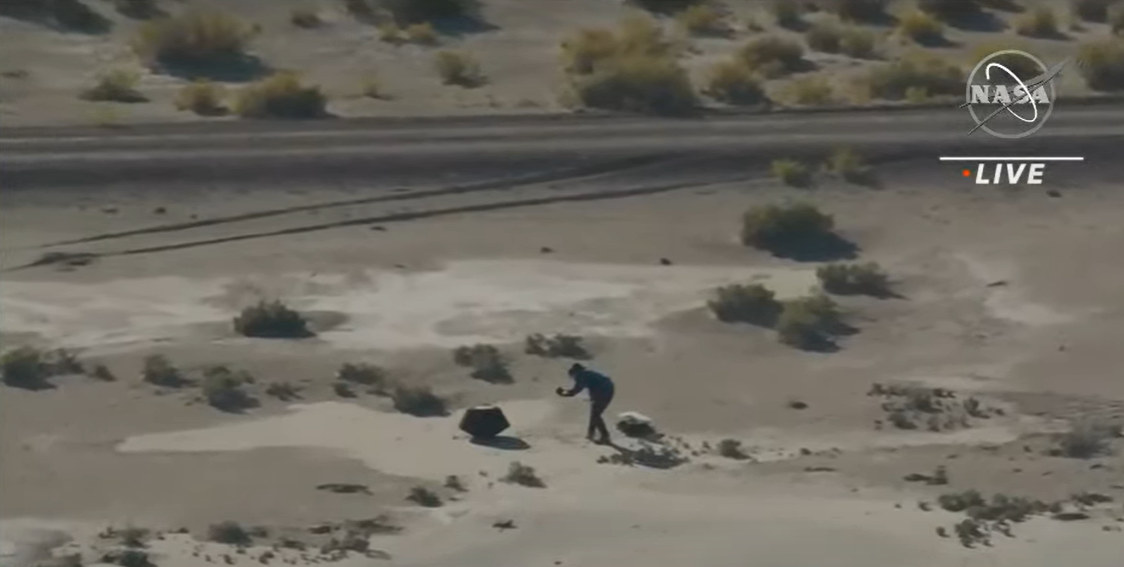
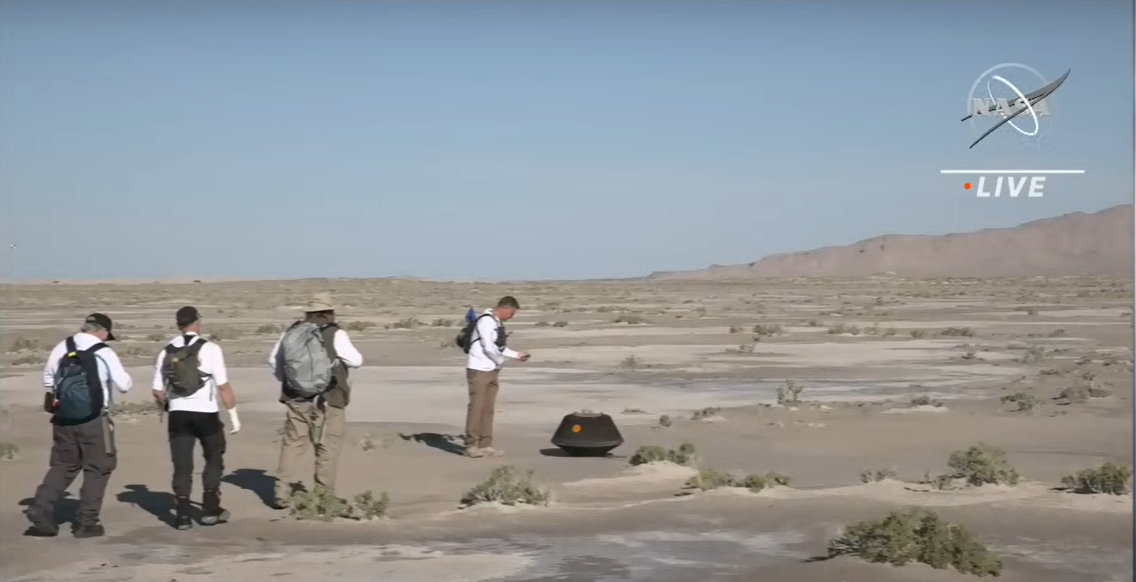
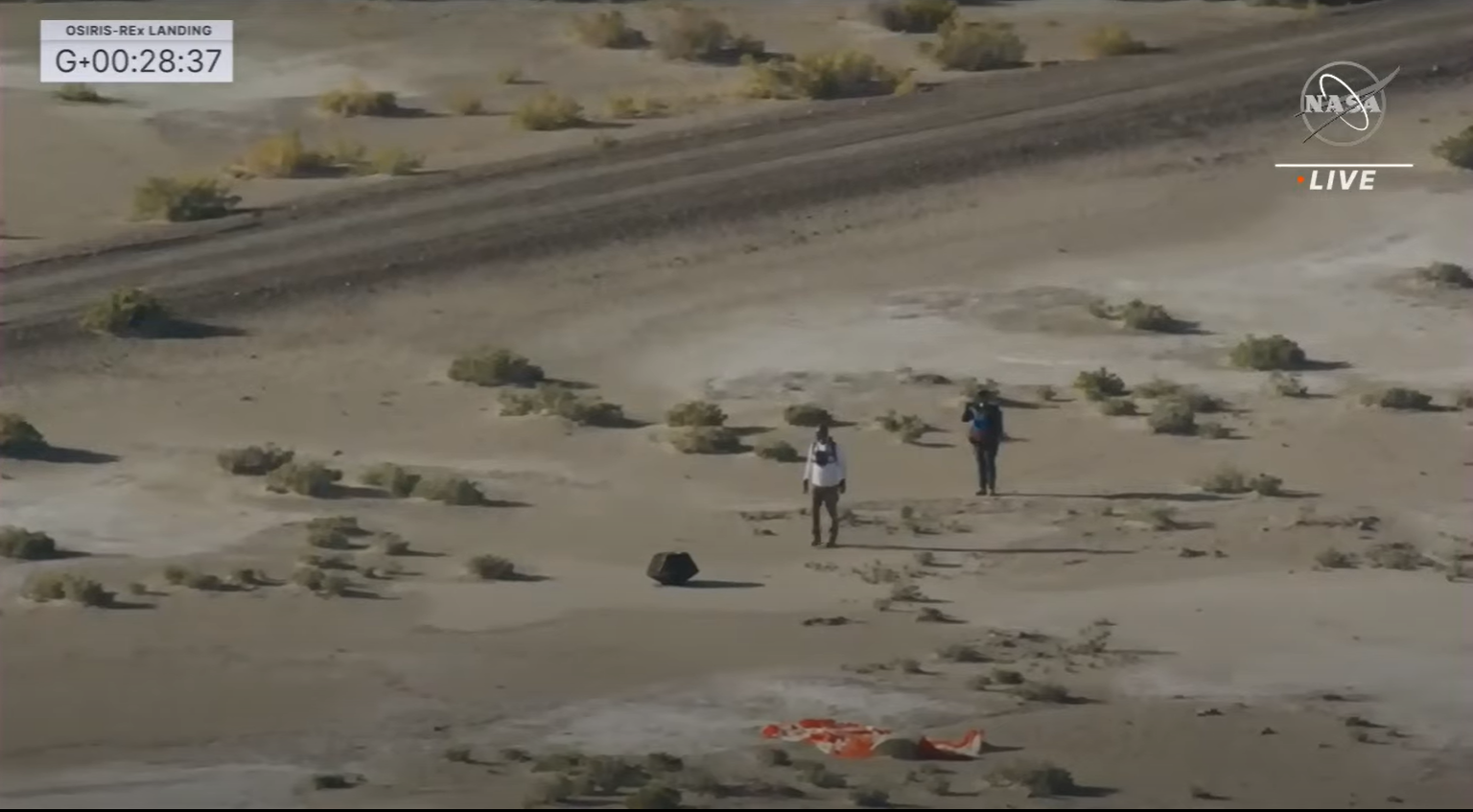
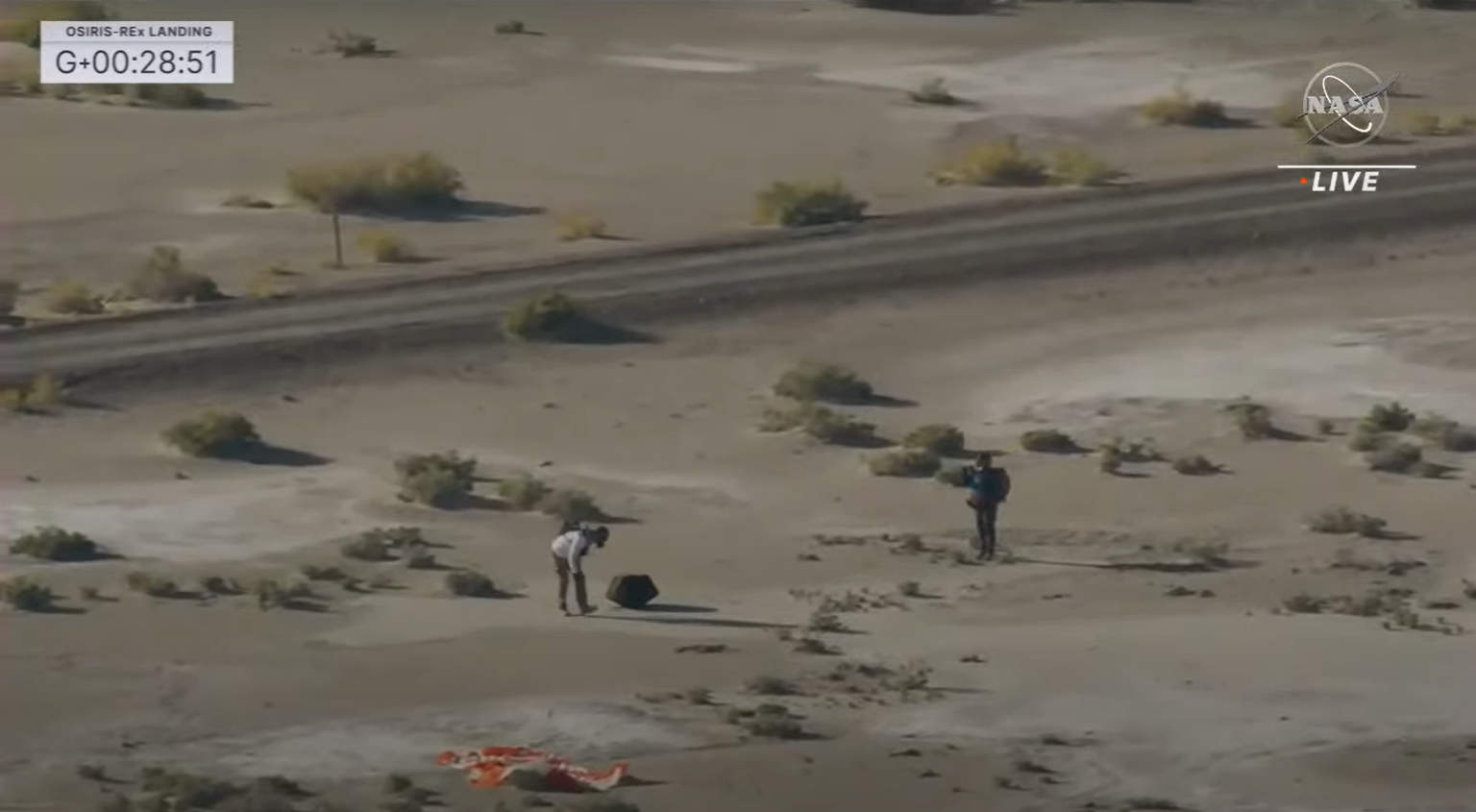
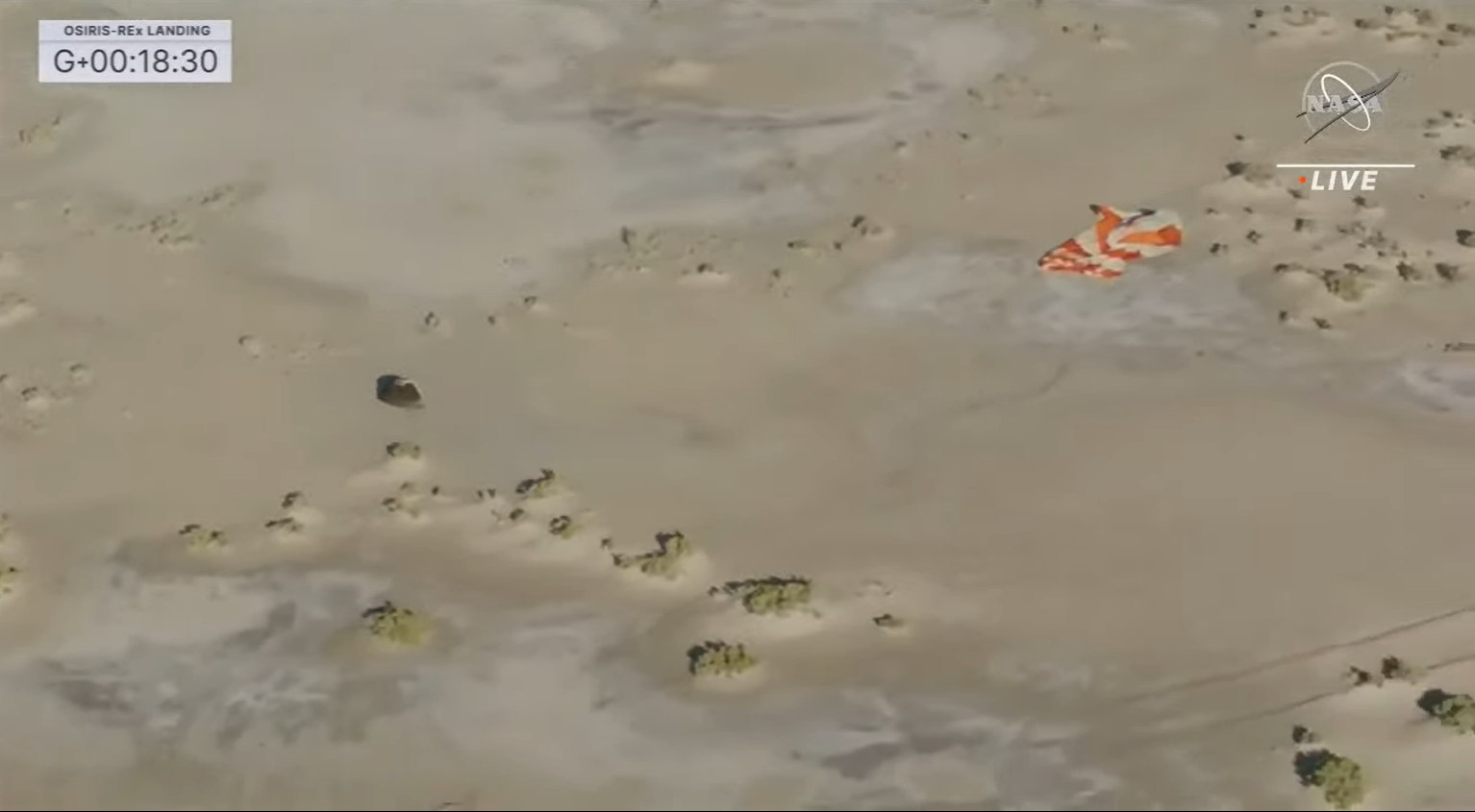
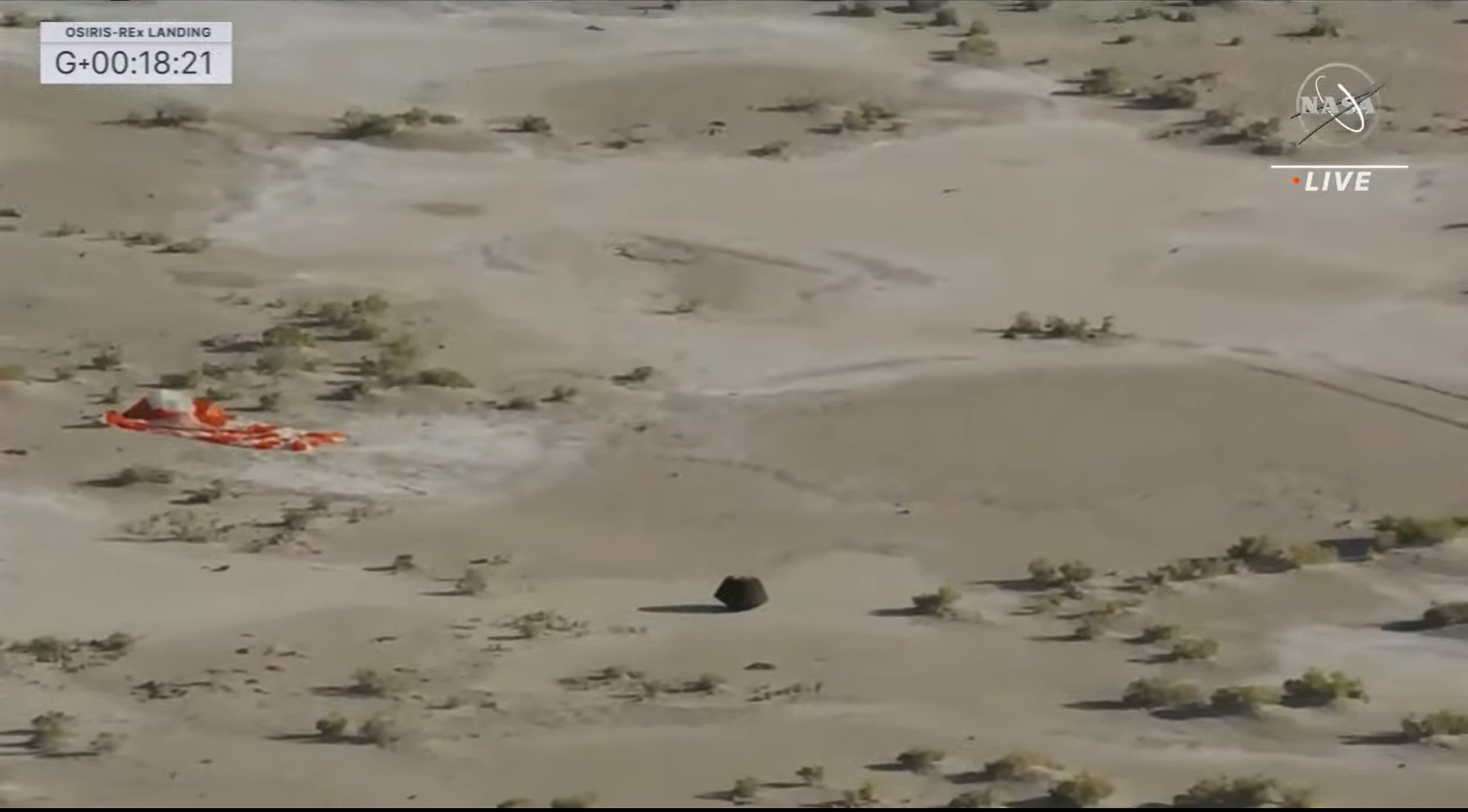
NASA recovery crews have reached the OSIRIS-REx asteroid sample return capsule and are working to safeguard the capsule so it can be air-lifted to a clean room at the Dugway Proving Ground.
The capsule is intact with no breaches, NASA reports.
OSIRIS-REx sample capsule wrapped for recovery
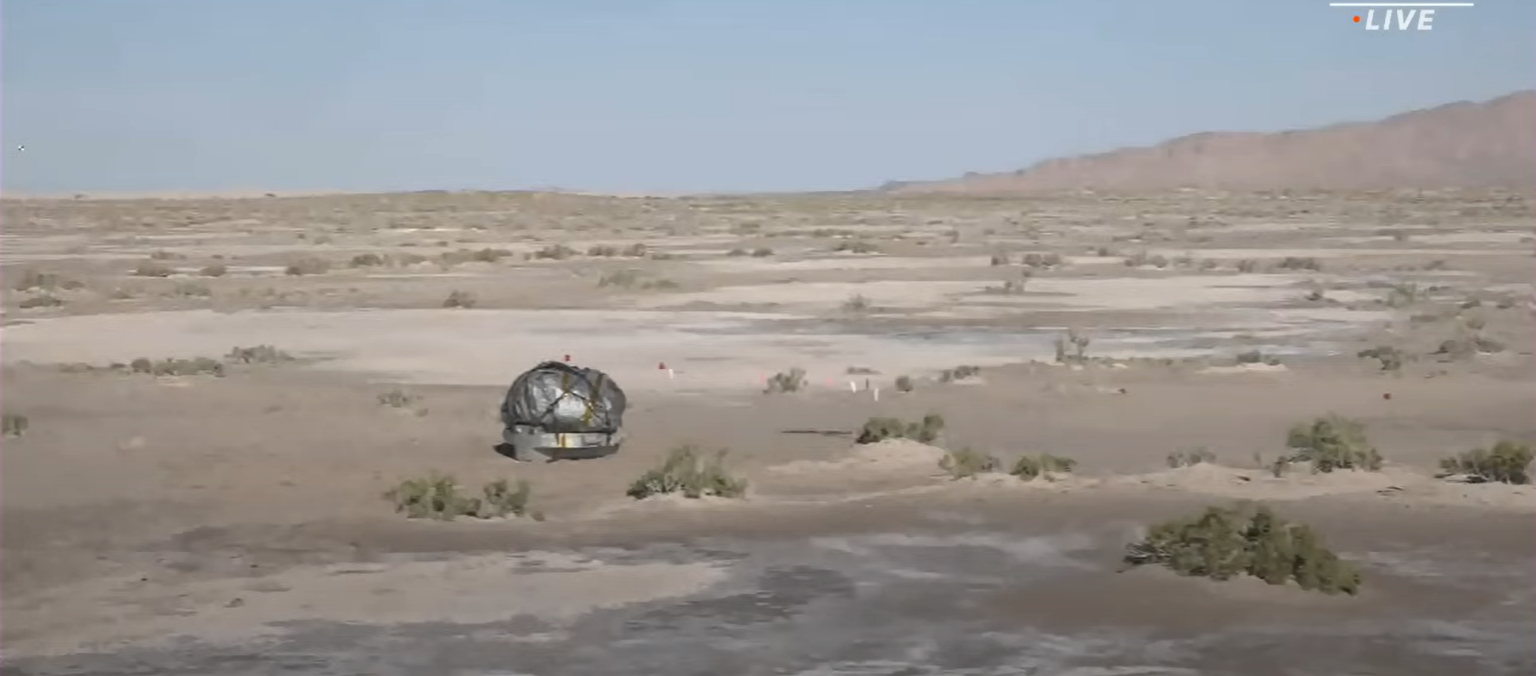
NASA's OSIRIS-REx recovery team has wrapped the 120-pound asteroid sample return capsule in a protective bag and cargo carrier and net so that it can be carried by helicopter to a clean room at the Dugway Proving Ground.
Helicopter retrieves OSIRIS-REx capsule
A recovery helicopter has successfully collected the OSIRIS-REx sample return capsule and is headed to a clean room at the Army's Dugway Proving Ground so it can be prepared for delivery to NASA's Johnson Space Center in Houston, Texas, where a special facility is awaiting its arrival.

NASA recovery teams have delivered the OSIRIS-REx sample return capsule to its Dugway Proving Ground processing site and are preparing to move it into a clean room in order to access the sample canister for delivery to the Johnson Space Center this week.
OSIRIS-REx samples inside clean room
Just over 2 hours after it landed on Earth, the asteroid sample return capsule from NASA's OSIRIS-REx mission was safely wheeled inside a temporary cleanroom at the Army's Dugway Proving Ground in Utah to be prepped for transport. With that, NASA has ended its webcast.
A NASA press conference on the OSIRIS-REx landing is scheduled for no earlier than 5 p.m. EDT (2000 GMT) today. We'll be back then with coverage of that meeting as well.
NASA will send the capsule and its contents to the Johnson Space Center in Texas, where the agency has built a special new facility to hold the samples for scientific study. The samples will be sent to JSC on Monday, NASA has said.
The space agency has set an Oct. 11 date for the opening of the sample canister at the new facility.
Thanks for joining Space.com for the OSIRIS-REx landing.
NASA press conference on OSIRIS-REx landing

With NASA's successful landing of the OSIRIS-REx asteroid sample return capsule a success, the space agency will celebrate the historic feat - a 1st for NASA - with a press conference at 5 pm ET (2100 GMT).
You can watch it live in the window at the top of this page.
OSIRIS-REx mission team hails landing success

Dante Lauretta, the principal investigator for NASA's OSIRIS-REx mission, says the team is overjoyed after the successful landing of the probe's asteroid sample return capsule today.
"Boy, did we stick the landing," Lauretta said during a post-landing press conference today.
Lauretta said there was some tense moments during the landing, especially after spending 20 years on the mission and 7 years actually flying it. One key moment was an early report that the probe's drogue chute had not been seen deploying.
"I was just trying to make sure I didn't totally break down in front of an international audience, right? It's like, okay, you got to keep it together," Lauretta said over the initial uncertainty about the drogue chute while he was riding in a recovery helicopter. But a few minutes later, the main parachute deployed and the landing was a resounding success.
"That's when I just emotionally just let it go. You know, tears were streaming down my eyes. I was like, okay, that's the only thing I needed to hear. From this point on, we know what to do. We're safe. We're home. We did it."
NASA is now shifting to preparing the asteroid Bennu samples for delivery to a new facility at the Johnson Space Center. We will end our landing day coverage and pickup on Monday with the capsule's departure for Houston. Thanks for tuning in! - Tariq Malik
OSIRIS-REx canister gets ready for Texan trip
Part of NASA's OSIRIS-REx descent capsule is readying for a move from Utah to Houston.
The asteroid return mission from Bennu is scheduled to head next to NASA’s Johnson Space Center in Houston after making a safe landing from space on Sunday (Sept. 24), closing out a seven-year journey.
"NASA's OSIRIS-REx clean room team has finished disassembling the sample capsule and packaging its components, including the unopened sample canister," NASA officials wrote in an update Sept. 24.
"Now packed in shipping containers – along with the environmental samples the recovery team collected around the capsule’s landing site this morning – the items are scheduled to be delivered."
NASA opens OSIRIS-REx asteroid sample canister

OSIRIS-REx's sample return canister has been opened after returning to Earth containing precious asteroid materials.
Scientists at NASA's Johnson Space Center (JSC) in Houston opened the lid on the canister on Tuesday (Sept. 26), two days after OSIRIS-REx's return capsule landed in a remote military base in the Utah desert. The canister contains samples of an asteroid known as Bennu.
"Scientists gasped as the lid was lifted," NASA's Astromaterials Research and Exploration Science (ARES) division, which is based at JSC, wrote Tuesday in a post on X (formerly Twitter).
The materials within will be carefully curated and divided up for study among scientific institutions and space agencies worldwide. For decades to come, the samples will be studied to help us learn more about the the solar system's formation and evolution, as well as the role that carbon-rich asteroids like Bennu may have played in bringing the building blocks of life to Earth.
Read more: NASA opens OSIRIS-REx's asteroid-sample canister (photos)
